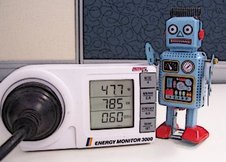
power meter, with qualified operator
With blackle being all the rage these days, we've been wondering if it makes a difference on an LCD monitor.
A CRT monitor has to illuminate each white pixel, so the brighter a pixel is, the more power required. LCDs are different though, as they have a single backlight, and an array of crystals which either block the light from the backlight or let it pass through (or something in between).
The theory here is that the backlight of the LCD is what uses most of the montior's current draw, and that the state of the pixels has negligible effect on this. Because the backlight is always on regardless of the image displayed, I'd expect the blackle website to be roughly equivalent (in terms of power usage) to google.
To test this, I used an AC current meter to measure the power consumption of a monitor while viewing the blackle and google websites. But to start with, I measured the current draw with the monitor displaying an all-white or all-black solid screen.
The instantaneous power consumption figures (in Watts) for the solid-colour tests look like this:
| Colour | Power (W) |
|---|---|
| White | 49.0 |
| Black | 46.3 |
It looks like the pixel colour has a non-negligible effect on the current draw of the monitor. I thought that the "resting" state of a LCD pixel was white, but this doesn't seem to be the case.
Watching a solid black screen isn't much fun though, so to repeat the test with the search engine pages:
| Website | Power (W) |
|---|---|
| google.com | 49.0 |
| blackle.com | 46.6 |
So, on my monitor (an IBM L20p, 20" at 1600 x 1200), using blackle instead of google saves around 3.4W.